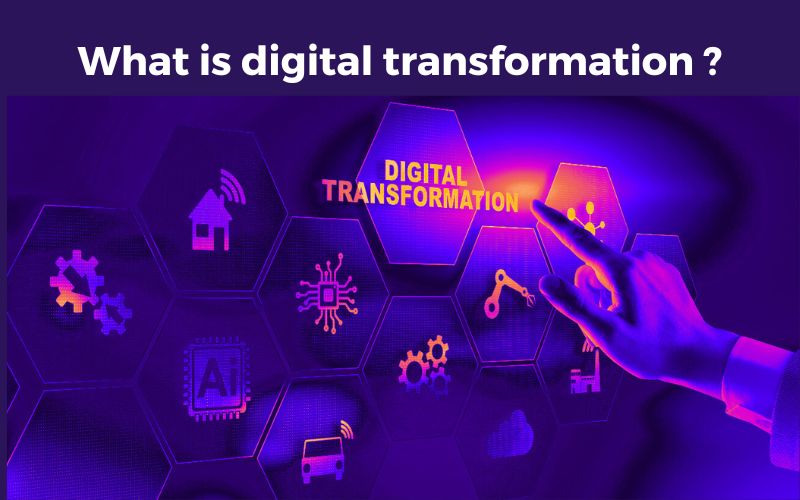Digital transformation refers to the integration of digital technologies into all areas of a business, resulting in fundamental changes to how businesses operate and deliver value to customers. The adoption of digital transformation has been rapidly increasing over the past decade, as more and more organizations realize the significant benefits it can bring to their operations and bottom line. In this article, we will explore the meaning of digital transformation, the benefits it offers, and the steps organizations can take to successfully implement it.
Digital transformation is the process of leveraging digital technologies to improve or transform business processes, customer experiences, and organizational performance. It is not simply the implementation of digital tools and systems, but rather a holistic approach to reimagining and redesigning business processes to leverage the potential of digital technologies.
Digital transformation can encompass a wide range of initiatives, from optimizing internal processes with automation and analytics to developing new products and services that are enabled by digital technologies. It can also involve the integration of technologies like the Internet of Things (IoT), artificial intelligence (AI), and blockchain into business operations.
Digital transformation can help organizations improve efficiency, streamline processes, and reduce costs, while also providing new opportunities for revenue growth and innovation. The benefits of digital transformation can be felt across all areas of a business, including marketing, sales, operations, and customer service.

Benefits of Digital Transformation
The benefits of digital transformation are numerous and can vary depending on the specific objectives of an organization. However, some of the most commonly cited benefits of digital transformation include:
Improved Efficiency: Digital transformation can streamline processes and automate manual tasks, resulting in increased efficiency and productivity. This can free up employees to focus on higher-value tasks and allow organizations to do more with less
Enhanced Customer Experience: Digital transformation can help organizations provide a more personalized and seamless customer experience across all touchpoints. This can improve customer satisfaction and loyalty, leading to increased revenue and repeat business.
New Revenue Streams: Digital transformation can open up new business opportunities by enabling organizations to develop and launch new products and services that leverage digital technologies. This can create new revenue streams and help organizations stay ahead of competitors.
Data-Driven Decision Making: Digital transformation can provide organizations with access to vast amounts of data, which can be analyzed to gain insights into customer behavior, market trends, and operational performance. This can help organizations make data-driven decisions that improve business outcomes.
Increased Agility: Digital transformation can make organizations more agile and responsive to changing market conditions and customer needs. This can help organizations stay ahead of competitors and adapt to new opportunities and challenges.

Steps to Successful Digital Transformation
While the benefits of digital transformation are clear, successfully implementing it can be a complex and challenging process. Here are some key steps organizations can take to ensure a successful digital transformation:
Define Objectives: Before embarking on a digital transformation initiative, organizations should clearly define their objectives and identify the areas of the business that are most in need of transformation. This can help ensure that resources are focused on the areas that will have the greatest impact.
Secure Executive Sponsorship: Digital transformation initiatives require strong leadership and support from the top of the organization. Executive sponsorship can help ensure that the initiative receives the necessary resources and attention to be successful.
Assess Current State: Organizations should conduct a thorough assessment of their current state, including their existing systems, processes, and culture. This can help identify areas that need to be addressed and provide a baseline for measuring progress.
Develop a Roadmap: Based on the objectives and current state assessment, organizations should develop a roadmap for digital transformation. This should include specific goals, timelines, and resource requirements for each phase of the initiative.
Build a Strong Team: Digital transformation initiatives require a team with a diverse set of skills, including technical, analytical, and business expertise. Organizations should invest in building

Type of Digital Transformation:
Digital Culture: Digital transformation involves more than just implementing new technologies. It also requires a shift in organizational culture towards a more digital-first mindset. This can involve encouraging experimentation and innovation, empowering employees to make data-driven decisions, and embracing new ways of working.
Digital Talent: To successfully execute a digital transformation initiative, organizations need to have the right talent in place. This can involve hiring new employees with digital skills, upskilling existing employees, and developing partnerships with external experts and vendors.
Cybersecurity: Digital transformation can increase an organization’s exposure to cyber threats, making cybersecurity a critical consideration. Organizations need to ensure that they have strong cybersecurity measures in place to protect against threats and minimize the risk of data breaches.
Change Management: Digital transformation can be a significant change for employees, and resistance to change can be a major obstacle. Effective change management is critical to ensuring that employees are engaged and supportive of the transformation.
Customer Data: Digital transformation often involves the collection and analysis of vast amounts of customer data. Organizations need to ensure that they are collecting data ethically and transparently, and that they are protecting customer privacy.
Overall, digital transformation is a complex and multifaceted process that requires careful planning and execution. By embracing digital technologies and redesigning business processes, organizations can unlock new opportunities for growth and innovation, while also improving efficiency, agility, and customer experience.







